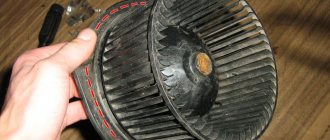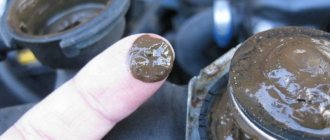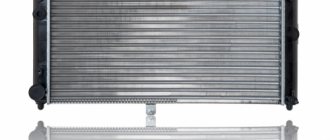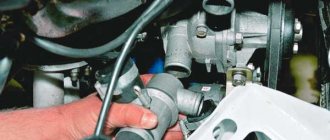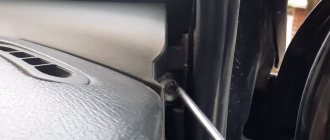No internal combustion engine can operate without proper cooling. There are many rubbing parts in the engine. If heat is not removed from them in a timely manner, the engine will simply jam. The radiator is a key element of the automotive cooling system. But it also needs regular washing. Let's figure out how to perform this procedure yourself.
- When should you flush the radiator?
- Various ways to flush the radiator without removing it
Washing with special means
- Washing with citric acid
Video: flushing the radiator with citric acid
Why does the radiator get dirty?
The reason for external contamination of the radiator is obvious: dirt gets on it directly from the road. The device is located in the engine compartment and does not have special protection. In the best case, a small shield can be installed under the radiator to prevent large stones and debris from getting into the fins of the device.
During operation, car radiators become dirty both inside and outside.
There are two reasons for internal pollution:
- dirt enters the cooling system from the outside. If there are cracks in the radiator hoses or in the radiator itself and the tightness of the system is broken, then its clogging is only a matter of time;
- The radiator becomes dirty due to poor antifreeze. It's no secret that finding high-quality antifreeze today is not so easy. The market is literally flooded with fakes. Antifreeze from well-known brands is especially often counterfeited.
Both dirty and fake antifreeze contain many foreign impurities. The radiator becomes very hot during operation. Sometimes antifreeze can even boil, and the impurities it contains form scale, which impedes the circulation of the coolant. Which leads to overheating of the motor.
Communities › VAZ: Repair and Modification › Forum › Flushing the cooling system
Hello. Anyone who knows, please tell me. How to flush the cooling system on a VAZ 21099 and what is the best way to do this? Thanks in advance.
This washing is a useless task... My friend was warming up 9... until he took off the head and just pulled it out... he picked the shirt with a screwdriver... the growths were crazy... now everything is ok.))
It doesn’t heat up for me, the antifreeze is just dirty. I want to wash it and change the antifreeze.
I washed with a butt =) An ordinary butt with the lower hose removed) It’s all just 25... 40... liters of water and voila! =) The car didn’t warm up, it’s just that some dirt was waving around and all the antifreeze is black and dirty... =) You fill it like this, wash it first, then you start it and there it is! =) With the pipes lowered by about a third. it goes slower there and the car doesn’t heat up) You keep an eye on the temperature and that’s all...=) Good luck =)
Thanks, I'll try it.
don’t forget that you need to pour it into all the cracks =) And under the lid and into the tank =) In everything, so that it is washed, and it’s better to wash everything separately separately. completely disconnect the radiator and go there! No matter what I want! =) You won’t freeze in the summer =) It’s better to have warm water, not cold =)
Got it, I'll get it done this weekend.
I washed it the other day, drained all the shit, then filled it with water with the drain bolts unscrewed, then tightened everything up, poured water and a special liquid for flushing the radiator, drove like that for a day, drained it and filled it with antifreeze. Everything is cheerful and now it’s not heating up at all
I rinse with vinegar essence. Pour 250-500 ml of essence onto the full cooling system. We run the engine at idle for 15-20 minutes, drain it, rinse it with water, and then pour in antifreeze.
Regarding vinegar) what should I dilute with?
Nothing. I filled the system with water, poured the essence on top and started warming up the engine.
how to mend a hole in a radiator?
It depends on what kind of radiator it is. If it is brass, then you can use plain tin. It is better to use one with a higher “refractoriness” coefficient. Well, be sure to go through the soldering areas with a file so that the surface is even, otherwise it will leak quickly.
But if the radiator is aluminum, then I won’t give you any advice. It's easier and cheaper to change it than to patch it.
And in general, it’s difficult to suggest anything in this regard without having an idea about the car and the places of the leak.
I rinse with vinegar essence. Pour 250-500 ml of essence onto the full cooling system. We run the engine at idle for 15-20 minutes, drain it, rinse it with water, and then pour in antifreeze.
When should you flush the radiator?
Here are the signs that the cooling system is clogged:
- the engine quickly overheats even in the cold season, after which power failures appear, which are especially noticeable when trying to accelerate;
- The “coolant” light is constantly on on the dashboard, although there is antifreeze. This is another typical sign of a clogged radiator.
A constant "coolant" light indicates a clogged radiator.
To avoid the above problems, car manufacturers recommend flushing cooling systems at least once every 2 years.
Various ways to flush the radiator without removing it
You can flush the radiator with various liquids. And the only tool the car owner will need is an open-end wrench to unscrew the drain plug in the cooling system. The washing sequence itself differs only in the type of liquid used and consists of the following steps:
- The car engine starts, idles for 10 minutes, then turns off and allows to cool for 20 minutes.
- The drain plug is unscrewed. The old antifreeze is drained. In its place, flushing liquid is poured.
- The engine starts again and runs for 10–15 minutes.
- After the engine has cooled, the liquid is drained. Distilled water is poured in its place to remove any remaining detergent from the radiator.
- New antifreeze is poured into the system.
Washing with special means
In any auto parts store you can find special compounds for flushing automobile cooling systems. There are many of them, but the most popular among car enthusiasts are two liquids: LAVR and Motorresurs.
LAVR and Motorresurs compositions are in great demand due to their affordable prices
They have an optimal price-quality ratio. The washing sequence is shown above.
Washing with citric acid
Acid dissolves scale well. To create an acidic environment in the radiator, drivers successfully use a solution of citric acid in water.
Citric acid solution dissolves scale well in the radiator
Here are the main features of the process:
- the solution is prepared in the proportion of 1 kilogram of acid per 10-liter bucket of water. If the radiator is not too clogged, the acid content can be reduced to 700 grams;
- flushing is carried out according to the scheme given above, with the exception of one important point: the hot acid solution is not drained from the system immediately, but after about an hour. This allows you to achieve the best effect.
Video: flushing the radiator with citric acid
About rinsing with distilled water
Distilled water is very rarely used as a standalone detergent. This is done only when the radiator is slightly dirty. The reason is simple: water does not dissolve scale. It only flushes out the debris and dirt that has accumulated in the radiator. It is for this reason that distilled water is usually used only for flushing the radiator after the main detergent.
Coca-Cola Rinse
Coca-Cola has many unusual uses. These include flushing the radiator.
Coca-Cola has long been used by motorists to clean the radiator of thick layers of scale.
Once in the cooling system and warmed up, the drink quickly dissolves even a very thick layer of scale. But there are two important points:
- The operating time of the motor when washing should be no more than 3 minutes. Then the engine is turned off, and the drink is drained from the system only after half an hour;
- It is necessary to rinse the system with water after Coca-Cola very carefully. The drink contains a lot of sugar. And it can settle on the radiator pipes.
How to rinse SOD?
- Water.
- Water with vinegar and acid.
- Special liquid for flushing the cooling system.
Flushing the cooling system with water
Although it is possible to flush the system with water, I would strongly advise against it. As I already said, it contains a large amount of impurities and salts that form scale. If there is no other option, then at least use distilled water. Flushing the cooling system using distilled water is done as follows:
- Pour water into the SOD.
- Start the engine and let it run for about half an hour.
- Then turn off the engine and drain the water from the system. Repeat the procedure until your flushing fluid is the same as before flushing. The disadvantages of this method include: scale formation, low efficiency (boiling water is not able to dissolve and wash scale and other deposits).
Flushing the cooling system with water, acid and vinegar
Water with vinegar and acid is a little better than just water, because thanks to acids you can remove scale and partially clean the cooling system. In order to flush the system using this method, prepare: caustic soda, lactic acid and vinegar. The acid is added carefully and a little at a time; if you overdo it, you can say goodbye to the plastic and rubber parts of the cooling system. To completely remove scale and dirt, it takes 5-10 hours, during which it is necessary to periodically warm up the engine to operating temperature. At the end, all the liquid is drained and distillate is poured in, which is used for the final flushing of the cooling system.
Washing SOD using special chemicals
Specialist. means are the most effective and expensive option. However, the effectiveness of such a procedure is worth the overpayment. Cleaning products contain special cleaning agents that actively remove scale, grease, organic matter, etc.
Flushing specials products are divided into four types: acidic, alkaline, two-component, neutral.
Acid and alkaline are considered the least popular; moreover, they are almost impossible to find undiluted. This is explained by their aggressive effect on the entire cooling system, essentially plastic and rubber products.
Two-component products are very popular and in great demand. Their 2-component solution consisting of alkali and acid copes well with the task. Each of the components is poured into the radiator in turn.
Neutral cooling system cleaning products contain aggressive substances, such as acids or alkalis, and are used exclusively for preventive purposes.
Summing up
As you can see, there are quite a few ways and means to clean the cooling system and each of them has its own characteristics. If you do not want to spend money on expensive cleaning products, follow basic rules that will prevent the formation of plaque and scale. Namely:
- Fill only with high-quality antifreeze.
- Monitor its condition regularly and replace it on time.
- From time to time, wash the SOD using special. facilities.
Sources:
https://m.etlib.ru/blog/560-chem-promyt-sistemu-ohlazhdeniya-dvigatelya?umt_source=rel_right_simple https://remam.ru/vozdsys/kak-samostoyatelno-prochistit-pechku-vaz-2115.html https://vaz-remont.ru/promyvka-sistemy-oxlazhdeniya-sposoby-nyuansy-rezultaty/
Cleaning the external elements of the radiator
The best option is to flush the radiator with water under pressure. This can be done either in your garage (if you have a suitable compressor) or at the nearest car wash.
The best option for external radiator cleaning is flushing with water under pressure.
This cleaning method perfectly removes even the smallest contaminants, such as poplar fluff that has accumulated between the fins of the radiator. But you need to remember the following:
- the water pressure should not be too strong, since the radiator fins are very thin and easily deformed;
- There should be no aggressive chemical additives in the water. Rubber hoses with clamps and gaskets are attached to the radiator. Aggressive detergents can corrode all this, and the cooling system will lose its seal.
Reasons for clogging
When using a car, small insects and sand get under the hood, so various debris gradually accumulates on the engine. Some accumulates in the radiator and mixes with the liquid. Gradually, the hoses become clogged, the unit ceases to function normally or even fails. Experienced drivers say that flushing the engine radiator should be done every 1 year/2 years.
For normal cleaning on all sides, it is better to remove the engine. However, this takes a long time. Therefore, car owners often think about how to flush the engine cooling radiator without removing it. Both store-bought products and traditional methods can help with this.
How to avoid radiator contamination
It will not be possible to completely isolate the radiator from dirt. All a car enthusiast can do is to ensure that the radiator does not become clogged for as long as possible. This can be achieved in the following ways:
- Use only high-quality antifreeze recommended by the car manufacturer. The brand and type of coolant can be found in the machine's operating instructions. And you can purchase such antifreeze at specialized service centers that have the appropriate certificates;
- Carry a supply of distilled water with you. When the driver discovers that there is no antifreeze, he usually fills the radiator with whatever he can get his hands on. This is usually water from a river or stream. The amount of scale that forms in the radiator after such water is enormous. Therefore, you should always have distilled water on hand. It will allow you to get to the garage and extend the life of the radiator.
Keeping a supply of distilled water in the trunk will help avoid radiator clogging
So, anyone who wants their car to run properly must keep the radiator clean. No special skills are required to wash it. All you need is an open-end wrench and a suitable detergent.
Description of the operating principle of the CO
On the VAZ 2114, the same scheme is used to cool the engine as on all other injection cars. Everything is based on heat exchange with a liquid (antifreeze, antifreeze or water).
The CO device consists of the following components:
- Electric motor;
- Pump (drives liquid through the system);
- Radiator;
- Thermostat (needed to regulate the operation of all components).
Under the action of a centrifugal pump, coolant circulates through all pipes. A special fan turns on/off depending on the sensor readings. It all depends on the temperature that is currently maintained in the car. If it exceeds 87 degrees, then two things happen:
- The thermostat valve opens, coolant flows into the large circle (passes through pipes through the engine and cools it).
- The fan turns on and blows onto the radiator grilles, thus reducing the coolant temperature.
The thermostat valve is a very important element of the entire cooling system. It is made of special technical wax, which, under the influence of a certain temperature, is deformed, releasing coolant (coolant) along a large circuit. The higher the temperature, the more it deforms. Thus, the amount of coolant supply is regulated, and therefore the intensity of cooling.
Incorrect thermostat operation
Checking the thermostat in a VAZ 2114
To check its operation you need to:
- Start the car and wait;
- When the engine temperature becomes high enough (reaches 97-98 degrees), you can draw certain conclusions by probing the lower pipe under the thermostat. If it is cold, it means the thermostat valve is not working properly.
Wear or lack of coolant
To replace antifreeze or antifreeze you need:
- Drain the old coolant;
- Clean the cooling system well;
- Fill with new coolant.
Many car enthusiasts have a problem with how to drain the liquid (antifreeze or antifreeze). If no big problems arise when working with an injection engine, then you will need to work a little with the radiator. Correct drainage diagram:
Checking the antifreeze level in the expansion tank
- Remove the engine protection;
- Move the stove temperature control to the far left position (highest temperature).
- Open the expansion tank;
- Place a container under the radiator to drain;
- Open the drain plug (try to do everything very slowly and carefully so as not to flood the generator);
- We wait about ten minutes.
After you have drained all the coolant, close all the plugs and fill with distilled water. Without overheating the engine, let it run for 10 minutes at low speed. Then turn it off and let it sit for another 10 minutes. If after draining the water is still dirty, the procedure must be repeated. We do this until the water becomes clear.
Violation of tightness in CO
The whole “salt” is that in a closed space, such as a cooling system, the boiling point becomes 130 degrees, and under normal conditions – 108. So any defect in the tightness can greatly affect the operation of the CO.
An excellent solution is to purchase a special antifreeze with fluorescent additives. Thanks to them, the liquid glows in ultraviolet light and it will be much easier to find the crack.
In most cases, all the necessary steps to repair the car’s vehicle can be done independently. So you can save your money and spend it on other purposes.
